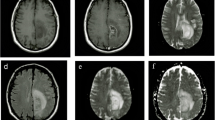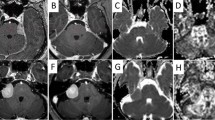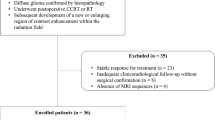Abstract
Pseudo-progression (PsP) refers to the paradoxical increase of contrast enhancement within 12 weeks of chemo-radiation therapy in gliomas attributable to treatment effects rather than early tumor progression (ETP). This study was performed to evaluate the utility of morphologic imaging features, diffusion tensor imaging (DTI) and radiation dosimetric analysis of magnetic resonance imaging (MRI) changes in differentiating PsP from ETP. Serial MRI examinations of 163 patients treated for high-grade glioma were reviewed. 46 patients showed a recurrent or progressive enhancing lesion within 12 weeks of radiotherapy. We used an in-house modified scoring system based on 20 different morphologic features (modified VASARI features) to assess the MRI studies. DTI analyses were performed in 24 patients. MRI changes were defined as recurrent volume (Vrec) and registered with pretreatment computed tomography dataset, and the actual dose received by the Vrec during treatment was calculated using dose–volume histograms. Bidimensional product of T2-FLAIR signal abnormality and enhancing component was larger in the ETP group. DTI metrics revealed no significant difference between the two groups. There was no statistically significant difference in the location of Vrec between PsP and ETP groups. Morphologic MRI features and DTI have a limited role in differentiating between PsP and ETP. The larger sizes of the T2-FLAIR signal abnormality and the enhancing component of the lesion favor ETP. There was no correlation between the pattern of MRI changes and radiation dose distribution between PsP and ETP groups.




Similar content being viewed by others
References
Stupp R, Mason WP, van den Bent MJ, Weller M, Fisher B, Taphoorn MJ, Belanger K, Brandes AA, Marosi C, Bogdahn U, Curschmann J, Janzer RC, Ludwin SK, Gorlia T, Allgeier A, Lacombe D, Cairncross JG, Eisenhauer E, Mirimanoff RO, European Organization for research and treatment of cancer, brain tumor and radiotherapy groups, National Cancer Institute of Canada Clinical Trials Group (2005) Radiotherapy plus concomitant and adjuvant temozolomide for glioblastoma. N Engl J Med 352:987–996
Brandsma D, Stalpers L, Taal W, Sminia P, van den Bent MJ (2008) Clinical features, mechanisms, and management of pseudoprogression in malignant gliomas. Lancet Oncol 9:453–461
Chamberlain MC, Glantz MJ, Chalmers L, van Horn A, Sloan AE (2007) Early necrosis following concurrent Temodar and radiotherapy in patients with glioblastoma. J Neurooncol 82:81–83
de Wit MC, de Bruin HG, Eijkenboom W, SillevisSmitt PA, van den Bent MJ (2004) Immediate post-radiotherapy changes in malignant glioma can mimic tumor progression. Neurology 63:535–537
Taal W, Brandsma D, de Bruin HG, Branberg JE, Swaak-Kragten AT, Smitt PA, van Es CA, van den Dent MJ (2008) Incidence of early pseudo-progression in a cohort of malignant glioma patients treated with chemoirradiation with temozolomide. Cancer 113:405–410
Young RJ, Gupta A, Shah AD, Graber JJ, Zhang Z, Shi W, Holodny AI, Omuro AM (2011) Potential utility of conventional MRI signs in diagnosing pseudoprogression in glioblastoma. Neurology 76:1918–1924
Jain R, Narang J, Arbab SA, Schultz L, Scarpace L, Mikkelsen T, Babajani-Feremi A (2011) Role of non-model-based semi-quantitative indices obtained from DCE T1 MR perfusion in differentiating pseudo-progression from true-progression. Neuro-Oncol 13:140
Kong DS, Kim ST, Kim EH, Lim DH, Kim WS, Suh YL, Lee JI, Park K, Kim JH, Nam DH (2011) Diagnostic dilemma of pseudoprogression in the treatment of newly diagnosed glioblastomas: the role of assessing relative cerebral blood flow volume and oxygen-6-methylguanine—DNA methyltransferase promoter methylation status. AJNR Am J Neuroradiol 32:382–387
Gahramanov S, Raslan AM, Muldoon LL, Hamilton BE, Rooney WD, Varallyay CG, Njus JM, Haluska M, Neuwelt EA (2011) Potential for differentiation of pseudoprogression from true tumor progression with dynamic susceptibility-weighted contrast-enhanced magnetic resonance imaging using ferumoxytol vs. gadoteridol: a pilot study. Int J Radiat Oncol Biol Phys 79:514–523
Pierpaoli C, Jezzard P, Basser PJ, Barnett A, DiChiro G (1996) Diffusion tensor MR imaging of the human brain. Radiology 201:637–648
Stadlbauer A, Ganslandt O, Buslei R, Hammen T, Gruber S, Moser E, Buchfelder M, Salomonowitz E, Nimsky C (2006) Gliomas: histopathologic evaluation of changes in directionality and magnitude of water diffusion at diffusion-tensor MR imaging. Radiology 240:803–810
Provenzale JM, McGraw P, Mhatre P, Guo AC, Delong D (2004) Peritumoral brain regions in gliomas and meningiomas: investigation with isotropic diffusion-weighted MR imaging and diffusion-tensor MR imaging. Radiology 232:451–460
https://wiki.cancerimagingarchive.net/x/wgEe Accessed 11 Nov 2011
Maes F, Collignon A, Vandermeulen D, Marchal G, Suetens P (1997) Multimodality image registration by maximization of mutual information. IEEE Trans Med Imaging 16:187–198
Ashburner J, Friston KJ (1999) Nonlinear spatial normalization using basis functions. Hum Brain Mapp 7:254–266
Wang S, Kim S, Chawla S, Wolf RL, Knipp DE, Vossough A, O’Rourke DM, Judy KD, Poptani H, Melhem ER (2011) Differentiation between glioblastomas, solitary brain metastases, and primary cerebral lymphomas using diffusion tensor and dynamic susceptibility contrast-enhanced MR imaging. AJNR Am J Neuroradiol 32:507–514
Wang S, Kim S, Chawla S, Wolf RL, Zhang WG, O’Rourke DM, Judy KD, Melhem ER, Poptani H (2009) Differentiation between glioblastomas and solitary brain metastases using diffusion tensor imaging. Neuroimage 44:653–660
Chan JL, Lee SW, Fraass BA, Normolle DP, Greenberg HS, Junck LR, Gebarski SS, Sandler HM (2002) Survival and failure patterns of high-grade gliomas after three-dimensional conformal radiotherapy. J Clin Oncol 20:1635–1642
Brandes AA, Franceschi E, Tosoni A, Blatt V, Pession A, Tallini G, Bertorelle R, Bartolini S, Calbucci F, Andreoli A, Frezza G, Leonardi M, Spagnolli F, Ermani M (2008) MGMT promoter methylation status can predict the incidence and outcome of pseudoprogression after concomitant radiochemotherapy in newly diagnosed glioblastoma patients. J Clin Oncol 26:2192–2197
Pouleau HB, Sadeghi N, Balériaux D, Melot C, DeWitte O, Lefranc F (2012) High levels of cellular proliferation predict pseudoprogression in glioblastoma patients. Int J Oncol 40:923–928
Jain R, Scarpace L, Ellika S, Schultz LR, Rock JP, Rosenblum ML, Patel SC, Lee TY, Mikkelsen T (2007) First-pass perfusion computed tomography: initial experience in differentiating recurrent brain tumors from radiation effects and radiation necrosis. Neurosurgery 61:778–786
Jain R, Narang J, Schultz L, Scarpace L, Saksena S, Brown S, Rock JJ, Rosenblum M, Gutierrez J, Mikkelsen T (2011) Permeability estimates in histopathology-proved treatment-induced necrosis using perfusion CT: can these add to other perfusion parameters in differentiating from recurrent/progressive tumors? AJNR Am J Neuroradiol 32:658–663
Narang J, Jain R, Arbab SA, Mikkelsen T, Scarpace L, Rosenblum ML, Hearshen D, Babajani-Feremi A (2011) Differentiating treatment-induced necrosis from recurrent/progressive brain tumor using non-model based semi-quantitative indices derived from dynamic contrast enhanced T1-weighted MR perfusion. Neuro-Oncol 13(9):1037–1046
Barajas RF, Chang JS, Sneed PK, Segal MR, McDermott MW, Cha S (2009) Distinguishing recurrent intra-axial metastatic tumor from radiation necrosis following gamma knife radiosurgery using dynamic susceptibility-weighted contrast-enhanced perfusion MR imaging. AJNR Am J Neuroradiol 30:367–372
Asao C, Korogi Y, Kitajima M, Hirai T, Baba Y, Makino K, Kochi M, Morishita S, Yamashita Y (2005) Diffusion-weighted imaging of radiation-induced brain injury for differentiation from tumor recurrence. AJNR Am J Neuroradiol 26:1455–1460
Sundgren PC, Fan X, Weybright P, Welsh RC, Carlos RC, Petrov M, McKeever PE, Chenevert TL (2006) Differentiation of recurrent brain tumor versus radiation injury using diffusion tensor imaging in patients with new contrast-enhancing lesions. Magn Reson Imaging 24:1131–1142
Zhang S, Bastin ME, Laidlaw DH, Sinha H, Armitage PA, Deisboeck TS (2004) Visualization and analysis of white matter structural asymmetry in diffusion tensor MRI data. Magn Reson Med 51:140–147
Rai V, Nath K, Saraswat VA, Purwar A, Rathore RK, Gupta RK (2008) Measurement of cytotoxic and interstitial components of cerebral edema in acute hepatic failure by diffusion tensor imaging. J Magn Reson Imaging 28:334–341
Saksena S, Jain R, Narang J, Scarpace L, Schultz LR, Rock JP, Rosenblum M, Patel SC, Mikkelsen T (2010) Predicting survival in glioblastomas using diffusion tensor imaging metrics. J Magn Reson Imaging 32:788–795
Wen PY, Macdonald DR, Reardon DA, Cloughesy TF, Sorensen AG, Galanis E, Degroot J, Wick W, Gilbert MR, Lassman AB, Tsien C, Mikkelsen T, Wong ET, Chamberlain MC, Stupp R, Lamborn KR, Vogelbaum MA, van den Bent MR, Chang SM (2010) Updated response assessment criteria for high-grade gliomas: response assessment in neuro-oncology working group. J Clin Oncol 28:1963–1972
Lee SW, Fraass BA, Marsh LH, Herbort K, Gebarski SS, Martel MK, Radany EH, Lichter AS, Sandler HM (1999) Patterns of failure following high-dose 3-D conformal radiotherapy for high-grade astrocytomas: a quantitative dosimetric study. Int J Radiat Oncol Biol Phys 43:79–88
Disclosure
The authors do not have any conflicts of interest.
Author information
Authors and Affiliations
Corresponding author
Electronic supplementary material
Below is the link to the electronic supplementary material.
Rights and permissions
About this article
Cite this article
Agarwal, A., Kumar, S., Narang, J. et al. Morphologic MRI features, diffusion tensor imaging and radiation dosimetric analysis to differentiate pseudo-progression from early tumor progression. J Neurooncol 112, 413–420 (2013). https://doi.org/10.1007/s11060-013-1070-1
Received:
Accepted:
Published:
Issue Date:
DOI: https://doi.org/10.1007/s11060-013-1070-1




